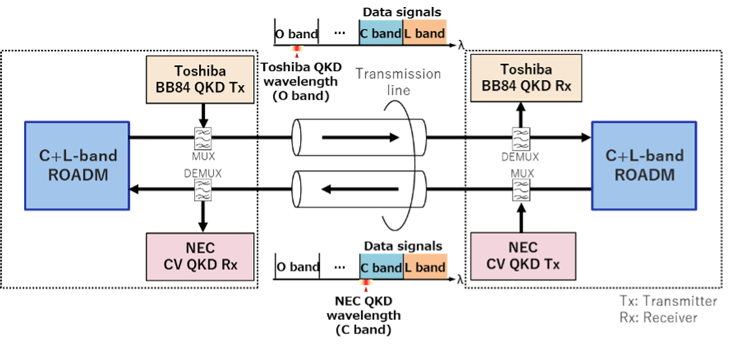Overview
Toshiba Corporation (“Toshiba”), NEC Corporation (“NEC”), and the National Institute of Information and Communications Technology (“NICT”) have successfully conducted the world’s first demonstration of multiplexed transmission of quantum key distribution (QKD) signals and key generation within a system environment designed for the IOWN all-photonics network. IOWN, developed by NTT, Inc., is a next-generation information processing and communications infrastructure that delivers ultra-high speed, low power consumption, and low latency.
For the demonstration, a large-capacity optical transmission system was built at NICT’s Quantum ICT Collaboration Center using the optical transmission equipment that comprises the open all-photonics network (Open APN), the proposed network infrastructure for realizing IOWN. The demonstration multiplexed high-speed data signals with two different types of QKD signals, developed by Toshiba and NEC separately, over the same transmission section.
This result shows that QKD networks can be built on current telecom backbone infrastructure, eliminating the need for dedicated optical fibers for QKD signals. This paves the way for delivering quantum cryptographic communication services to users across wide areas at low cost. As the practical adoption of quantum cryptographic communication advances, it is expected that multiple types of QKD signals will coexist on the same transmission section, to enhance network reliability. The successful multiplexed transmission of two types of QKD signals in the demonstration supports the broader adoption of quantum cryptographic communications and contributes to the realization of a more secure communications infrastructure.
Part of this research and development was supported by Japan’s Ministry of Internal Affairs and Communications Research and Development of ICT Priority Technology Project (JPMI00316) “R&D for construction of a global quantum cryptography network.”
Development background
QKD technology enables information-theoretically secure sharing of encryption keys necessary for cryptographic communications. Security is guaranteed by the principles of quantum mechanics, allowing two communicating parties to securely share keys by reliably detecting any eavesdropping on the transmission line.
Widespread use of encrypted communications using keys shared via QKD technology, and the realization of a safe and secure networked society, requires building QKD networks at the scale of inter-city connections. To deploy such networks, trial environments for potential users are currently being developed, provided, and tested around the world. These environments are built as proprietary infrastructure using dark fiber to transmit single-photon level QKD signals under ideal conditions, in order to maximize key generation rates, and they are managed under operational rules different from those for optical data transmission networks. However, such dedicated infrastructure requires securing dark fibers and implementing specialized management and maintenance procedures, resulting in high deployment and operational costs. This could limit future expansion of networks and the widespread delivery of services to users.
To deploy QKD networks over wide areas at low cost, an efficient approach is to integrate and multiplex them into optical data transmission networks that are being widely deployed by telecommunications carriers, rather than building a proprietary infrastructure using dedicated dark fibers. In particular, in order to promote QKD services, it is important that they work over IOWN Open APN, which is expected to be the next-generation network infrastructure in the Beyond 5G era.
Features of the technology
The demonstration was conducted at NICT’s Quantum ICT Collaboration Center, under environments that simulated a backbone optical network operated by a telecommunications carrier. A ROADM system compatible with the C+L wavelength bands, intended for deployment in telecom carriers’ backbone optical networks, was constructed using NEC’s open optical transport products (SpectralWave WX Series), which serves as components of the IOWN Open APN. Coexistence transmission was performed in which high-capacity optical signals for data communication and two different types of QKD signals were multiplexed over the same transmission section.
For the QKD schemes, Toshiba adopted Bennett-Brassard 84 (BB84), a protocol whose security is theoretically proven based on quantum mechanics, while NEC adopted the continuous-variable (CV), a protocol that enables easier in-band multiplexing with data signals, as well as compact and low-cost implementation. The two types of quantum signals in QKD, along with their respective control signals, were transmitted over two-core optical fibers, each of which is assigned to different propagation direction. To simulate the actual environment used in the optical backbone networks of telecommunication carriers, dummy optical signals for data communication equivalent to a total capacity of 47.2 Tbps were multiplexed with the QKD signals on the same fiber, spanning the full C and L wavelength bands with an optical output power with +17 dBm. Wavelength assignment was carefully controlled to prevent interference between the signals, and the transmission took place over a distance of 25 kilometers. Under these conditions, the simultaneous generation of encryption keys by the two QKD protocols was successfully demonstrated over an 8-hour continuous period. It was also confirmed that main signals for high-speed data transmission, with 400 Gbps and 800 Gbps per wavelength, assigned within the C and L band ranges, could be transmitted error-free while coexisting with single-photon-level QKD signals.
The demonstration involved multiplexed transmission of QKD signals on the transmission line of the Open APN backbone optical network. This meets a use case for the One-span PtP Wavelength Path service, a new addition to the Open APN Functional Architecture Release 3 document published by the IOWN Global Forum. The results indicate that, in future deployment of backbone optical networks based on the IOWN Open APN, it will be possible to apply multiple QKD protocols simultaneously to achieve higher availability. This suggests that a highly reliable and wide-area QKD network can be deployed at low cost.

Figure 1: Experimental setup to demonstrate the coexistence of QKD links and a high-capacity optical transmission system
Future developments
Toshiba, NEC, and NICT will continue to accelerate research and development of QKD network technologies in order to contribute to the deployment of QKD services over all-photonics networks operated by telecommunications carriers. Through application in a wide range of use cases, such as cloud services, finance, and government agencies, the three organizations aim to contribute to the realization of a safe and secure information society.
 toshiba.co.jp
toshiba.co.jp